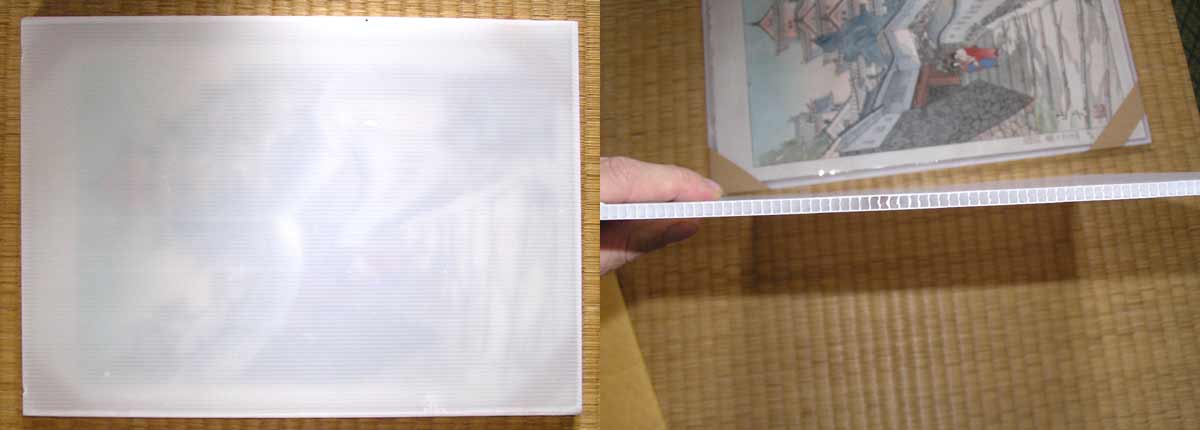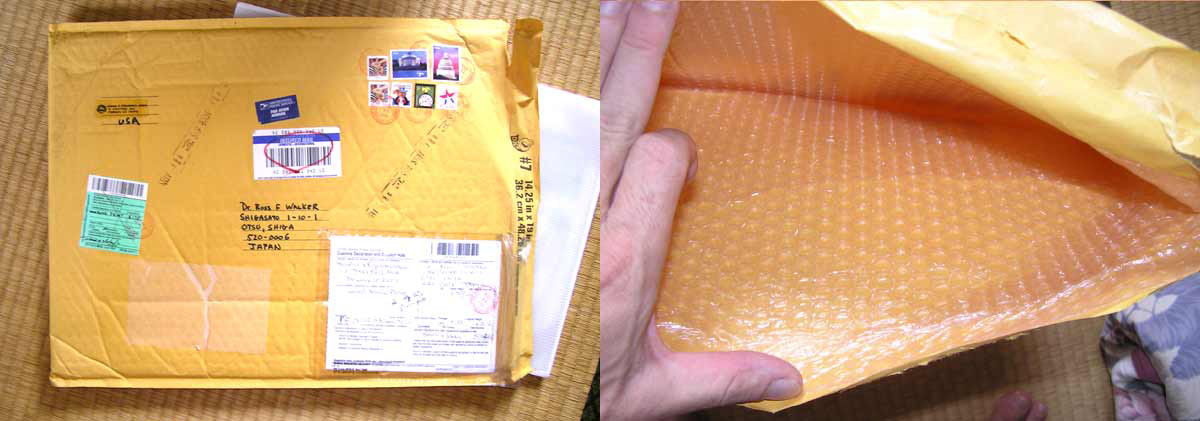
Inexpensive and Safe Shipping of Woodblock Prints
Shipping woodblock prints interstate or overseas need not be an expensive exercise. With an appropriate choice of strong yet lightweight materials it is possible to safely ship woodblock prints very economically. Here is a packaging method that I and other collectors use to ship prints. This method will be cheaper than buying a bulky box to ship the prints in. You'll need:
- a flat plastic bag or plastic slip to place the prints in;
- Several pieces of foam-board (see Figure 1) that is commonly used behind pictures in picture frames. An alternative is a 'corrugated plastic' sheet that looks just like corrugated cardboard, only it is plastic. Both are strong and lightweight. Thin plyboard (3 to 5 ply) is also excellent. You can probably get the foam-board from an art supply or picture framing shop. The corrugated plastic can usually be bought from a DIY hardware store.
- A Jiffy padded envelope (see Figure 2), bubble wrap, or a sheet of thick wrapping paper.
- Sticky tape (Cello tape).

Figure 1: Corrugated plastic sheet is usually available at hardware or DIY stores. Foam-board, as used in picture frames, is also a good replacement. You'll need several sheets that are cut about 10cm (4 inches) larger than the woodblock print dimensions.

Figure 2: A jiffy padded envelope (left); Close-up view of the inside of a Jiffy padded envelope (right), showing a layer of bubble-wrap on each envelope face.
Here's how to package the print/s:
- Place the prints in the plastic bag and fold the edges of the bag under the prints if the bag is too large;
- Cut several sheets of foam-board so that they are about 10 centimetres greater than the print size. I.e., if the prints are 25 x 35cm, cut the sheets approximately 35 x 45 cm. Some brands of foam-board are quite thick and thus two sheets may be sufficient, but for standard foam-board I'd recommend at least three sheets for domestic shipping and at least four for international shipping.
- Centre the plastic bag containing the print(s) on one of the foam-board sheets, so that there are 5 centimetre (2 inch) margins on each side. Then tape each corner of the plastic bag to the foam-board.
- Place the other sheets of foam-board above and below the first sheet so that the prints are now sandwiched between the layers of foam-board sheet. Then securely tape the foam-board sheets together. If you're using plyboard, a total of two sheets (one above the print, one below) is more than sufficient.
- Place the sandwich in the Jiffy padded bag, or wrap the sandwich in the thick wrapping paper or bubble-wrap.
That's it! Simple, light and strong. The combined weight including several oban-sized prints (25 x 40cm, 15 x 10 inches) is usually less than a pound (400 grams). Out of all the shipments of prints I've received (well over a thousand packages to date), this method is the best, and because it is such a light package, you can usually send several oban-sized prints for only about US$15 via USPS First Class International Mail from the USA to most countries in the world.
Note 1: if you're worried about puncture-type damage (for example, the package being skewered by a sharp object) you can easily substitute two sheets of thin plywood for two foam-board sheets. This will increase the total package weight slightly but will also add a further level of protection.
Note 2: If you want to use corrugated cardboard, use more than four sheets, or a mix of cardboard and plastic/foam/plyboard sheets. Corrugated cardboard easily bends along the corrugations so it is much weaker than foamboard. To help increase the strength of the package, cut the cardboard sheets so that the corrugations of alternate sheets run at 90 degrees to each other. I.e., the first sheet has horizontal corrugations, the next sheet has vertical corrugations, etc. Strong "two-ply" cardboard is much stronger.

Figure 3: Here we show steps 1 to 3. The print has been placed in a plastic bag, centered onto one of the pre-cut corrugated plastic sheets, and then taped down at all four corners. Note: the plastic sheet margins should be larger than shown in my example: at least 1 inch (2.5cm) on each side. I recommend 2 inch margins.

Figure 4: Step 4: placing the 2nd pre-cut corrugated plastic sheet over the first, wafering the print in-between.





